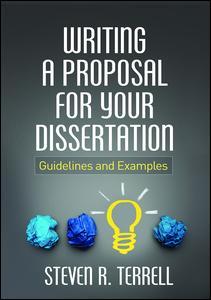Writing a Proposal for Your Dissertation Guidelines and Examples
Auteur : Terrell Steven R.

This book has been replaced by Writing a Proposal for Your Dissertation, Second Edition, ISBN 978-1-4625-5023-4.
1. Developing the Problem Statement for Your Dissertation Proposal
Introduction
The Doctoral Experience
The Problem Is the Problem
Finding a Good Research Problem
Characteristics of a Good Problem
Writing the Problem Statement
The Problem Statement as Part of a Dissertation Proposal
Summary of Chapter One
Do You Understand These Key Words and Phrases?
Let’s Start Writing Our Own Proposal
2. Writing Purpose Statements, Research Questions, and Hypotheses
Introduction
The Quantitative Purpose Statement
Purpose Statements for Qualitative Studies
Defining and Describing a Research Question
The Methodological Point of Departure
Research Questions Will Ultimately Lead to the Study’s Research Method
Getting Back to Stating Our Research Question
A Word of Caution!
Putting It Together: Problem Statements, Purpose Statements, and Research Questions
Problem Statements, Purpose Statements, and Research Questions in the Literature
Stating Hypotheses for Your Research Study
An Example of Stating Our Hypotheses
Understanding the Four Basic Rules for Hypotheses
The Direction of Hypotheses
Hypotheses Must Be Testable via the Collection and Analysis of Data
Research versus Null Hypotheses
All Hypotheses Must Include the Word “Significant”
Other Parts of Chapter 1 of the Dissertation
Summary of Chapter Two
Do You Understand These Key Words and Phrases?
Review Questions
Progress Check for Chapter 1 of the Dissertation Proposal: The Introduction
Let’s Continue Writing Our Own Dissertation Proposal
3. Writing the Review of Literature for Your Study
Introduction
What Is a Review of Literature and What Is Its Purpose?
There Isn’t a Magic Formula for Writing a Review of Literature
Phase 1. Getting Ready to Write a Review of Literature
Phase 2. Writing the Review of Literature
Summary of Chapter Three
Do You Understand These Key Words and Phrases?
Review Questions
Progress Check for Chapter 3 of the Dissertation Proposal: The Review of Literature
Let’s Continue Writing Our Own Dissertation Proposal
4. The First Part of Your Dissertation Research Method
Introduction
Philosophy 101
The Research Paradigm
Nonrandom (Nonprobabalistic) Sampling
Identifying the Population and a Sample for Your Study
Summary of the Sampling Process
Data Collection Instruments
Instruments for Quantitative Research
Instruments for Qualitative Research
Reliability and Validity
Plans for Data Analysis
Ethical Considerations
Plans for Presenting the Results
Summary of Your Proposal
Summary of Chapter Four: The First Part of Your Dissertation Research Method
Do You Understand These Key Words and Phrases?
Review Questions
5. Quantitative Research Methods
Introduction
Different Types of Data
Quantitative Research Designs
Survey Research
Correlational Research
Causal–Comparative Research
Hypothesis Testing
Experimental Research
The Validity of Your Study
Threats to the Internal Validity of Your Study
Threats to the External Validity of Your Study
Experimental Research Designs
Preexperimental Designs
Quasi-Experimental Designs
Experimental Designs
Putting This All Together for the Quantitative Dissertation Proposal
Chapter 3 of a Quantitative Dissertation Proposal
Our First Example of Chapter 3 of a Proposal
Summary of Chapter Five
Do You Understand These Key Words and Phrases?
Review Questions
Progress Check for Chapter 3 of a Quantitative Dissertation Proposal
Let’s Continue Writing Our Own Dissertation Proposal
Appendix 5.1. Example of a Descriptive Research Study
Appendix 5.2. Example of a Correlational Research Study
Appendix 5.3. Example of a Quasi-Experimental Research Study
Appendix 5.4. Example of an Experimental Research Study
Appendix 5.5. Threats to the Validity of an Experimental Study
6. Qualitative Research Methods
Introduction
An Overview of Qualitative Methodologies
The Role of the Researcher
The Format of a Qualitative Dissertation Proposal
Chapter 1 of a Qualitative Dissertation Proposal: The Introduction
Chapter 3 of a Qualitative Dissertation Proposal: Research Methods
Choosing the Right Qualitative Research Method
Participants and Sampling
Instruments
Research Procedures
Plans for Data Analysis
The Validity and Reliability of a Qualitative Study
Ethical Considerations
Plans for Presenting the Results
Summary
Summary of Chapter Six
Do You Understand These Key Words and Phrases?
Review Questions
Progress Check for Chapter 3 of a Qualitative Dissertation Proposal
Let’s Continue Writing Our Own Dissertation Proposal
Appendix 6.1. Narrative Study Procedures: The Case of the Unfortunate Departure
Appendix 6.2. Phenomenological Study Procedures: The Case of Sending Your Child to Safety
Appendix 6.3. Ethnographic Study Procedures: The Case of Climbing the Mountain
Appendix 6.4. Case Study Procedures: The Case of the Standardized Test
Appendix 6.5. Grounded Theory Procedures: The Case of Homelessness
Appendix 6.6. Content Analysis Procedures: The Case of the Eye Witness
7. Mixed Methods Research Designs
Introduction
An Overview of Mixed Methods Research
The Format of a Mixed Methods Proposal
Chapter 1 of a Mixed Methods Study: The Introduction
Background, Statement of the Problem, and Significance of the Study
The Central Purpose of the Study
Research Questions
Hypotheses for Mixed Methods Studies
Chapter 2 of a Mixed Methods Dissertation Proposal: The Review of Literature
Chapter 3 of a Mixed Methods Dissertation Proposal: Research Methods
The Mixed Methods Paradigm
Research Design
The Three Major Mixed Methods Designs
Participants and Sampling
Instruments
Research Procedures
Plans for Data Analysis
Ethical Considerations
Plans for Presenting the Results
Summary of Chapter Seven
Do You Understand These Key Words and Phrases?
Review Questions
Progress Check for Chapter 3 of a Mixed Methods Dissertation Proposal: The Research Methods
Appendix 7.1. Sequential Explanatory Design: The Case of the Tutors
Appendix 7.2. Sequential Exploratory Design: The Case of the Academies
Appendix 7.3. Convergent Design: The Case of Calling It In
Epilogue: Have We Accomplished What We Set Out to Do?
Appendix A. Progress Check for Chapter 1 of a Dissertation Proposal: The Introduction
Appendix B. Progress Check for Chapter 2 of a Dissertation Proposal: The Review of Literature
Appendix C. Progress Check for Chapter 3 of a Quantitative Dissertation Proposal
Appendix D. Progress Check for Chapter 3 of a Qualitative Dissertation Proposal
Appendix E. Progress Check for Chapter 3 of a Mixed Methods Dissertation Proposal
Answers to Review Questions
Glossary
References
Index
About the Author
Date de parution : 12-2015
17.8x25.4 cm
Disponible chez l'éditeur (délai d'approvisionnement : 13 jours).
Prix indicatif 35,19 €
Ajouter au panier


